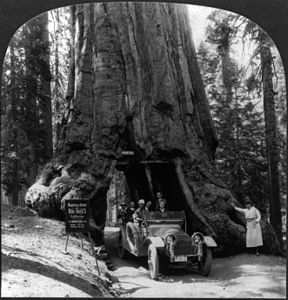Wawona Tree facts for kids
Quick facts for kids Wawona Tree |
|
|---|---|

Wawona Tunnel Tree, June 1918
|
|
| Species | Giant sequoia (Sequoiadendron giganteum) |
| Location | Mariposa Grove, Yosemite National Park, California, US |
| Coordinates | 37°30′53″N 119°35′42″W / 37.51470°N 119.59494°W |
| Date felled | February 1969 |
The Wawona Tree, also known as the Wawona Tunnel Tree, was a very famous giant sequoia tree. It grew in Mariposa Grove, which is part of Yosemite National Park in California, USA. This huge tree stood tall until February 1969.
The Wawona Tree was about 69 meters (227 feet) tall. Its base was around 7.9 meters (26 feet) wide. The word Wawona might have come from the Miwok language. Some people say it meant "big tree" or "hoot of the owl." Owls and other birds were seen as special protectors of sequoia trees.
Contents
The Wawona Tunnel Tree: A Look Back
A tunnel was cut through the Wawona Tree in 1881. This tunnel made an existing fire scar much bigger. Two brothers, the Scribners, were paid $75 to do the work. The tree already leaned a little, and it leaned more after the tunnel was finished.
Why Was a Tunnel Cut Through the Tree?
The Yosemite Stage and Turnpike Company created this tunnel. They wanted it to be a fun attraction for tourists. People loved driving their cars or horse-drawn carriages right through the giant tree! Many visitors took photos driving or standing inside the tunnel.
This tunnel was part of a bigger plan by the National Park Service. They wanted more people to visit national parks, especially those traveling by car. Leaders like Stephen Mather and Horace Albright believed that more visitors would help the parks get more money. They wanted to make parks easy to reach and very memorable.
They worked to make parks like Yosemite, Yellowstone, and the Grand Canyon popular for car trips. Roads and roadside attractions, like the Tunnel Tree, became common. They felt that good roads would help everyone enjoy the parks, even those who couldn't hike far.
When Did the Wawona Tree Fall?
The Wawona Tree fell in February 1969. It fell because of a very heavy load of snow on its top branches. Experts believe this giant sequoia was about 2,300 years old when it fell.
When the huge tree came down, people discussed what to do with it. It was decided to leave the tree where it fell. This was mainly for nature's sake. Fallen giant sequoias create new homes for insects and animals. They also help new plants grow. Today, the tree is known as the Fallen Tunnel Tree. It is still a popular spot for visitors to see.
Other Uses of the Wawona Tree Symbol
The company Pacific Life chose the Wawona Tree as its symbol in the early 1900s. They felt it showed strength, long life, and safety. In 1956, they asked an artist named Spero Anargyros to carve a model of the Wawona Tree. This carving was placed in their office in San Francisco.
Other Famous Tunnel Trees
Many large trees in California had tunnels cut through them in the late 1800s and early 1900s. These tunnels allowed people to drive, bike, or walk through the trees. However, cutting tunnels caused serious harm to the trees' health. Because of this damage, people no longer create new tunnel trees.
Giant Sequoia Tunnel Trees
The Wawona Tree was a giant sequoia. Another giant sequoia that people could drive through has also fallen:
- The Pioneer Cabin Tree fell in 2017 in Calaveras Big Trees State Park.
But two giant sequoia tunnel trees that you can walk through are still standing:
- The California Tunnel Tree is in Mariposa Grove, Yosemite National Park. Its tunnel was dug in 1895 for horse-drawn carriages. Today, people can walk or bike through it.
- A dead tunnel tree is in Tuolumne Grove, Yosemite National Park. This was the first standing sequoia to have a tunnel cut through it.
Coast Redwood Tunnel Trees
Some tunnel trees are coast redwoods, which are taller and thinner than giant sequoias.
- The Chandelier Tree is a famous tunnel tree that is a coast redwood.
- Two other drive-through coast redwood trees are still standing. You can find them along US 101 in northern California, near Klamath and Myers Flat.
Images for kids



